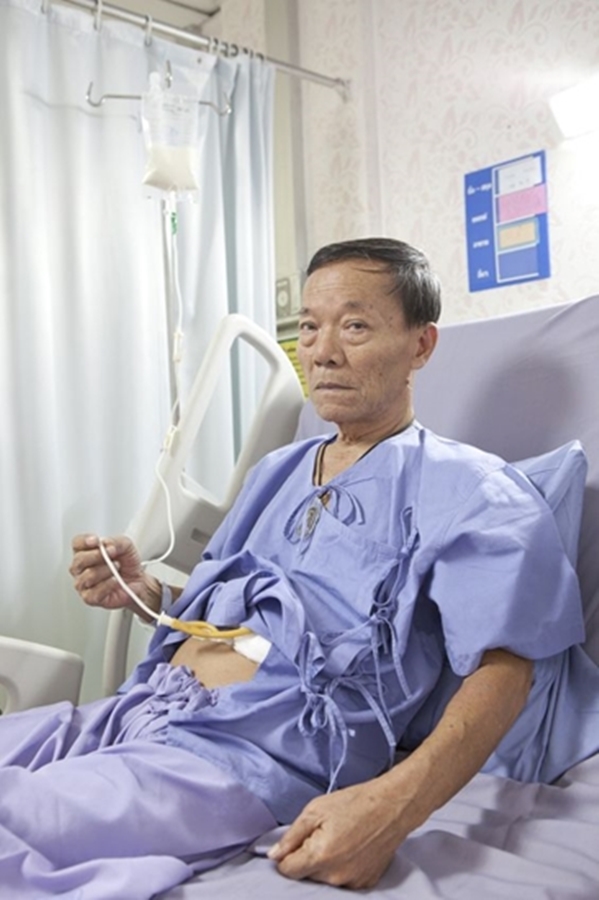Inserting an NG Tube
- Help your family member to sit up or raise the head of their bed to at least 30 degrees.
- Place protective towels around them if the insertion process stimulates their gag reflex and they vomit or spit up.
- Choose which nostril to use by evaluating for tenderness, previous injury, or the bone structure of the nasal cavity that could affect the ease of insertion.
- Determine the distance you need to advance the tube by measuring against external landmarks.
- Place the distant tip of the NG tube at the end of your family member’s nose and stretch the tube from the nose to the earlobe on the same side as the nostril. Continue to extend the tube toward the xiphoid process (The xiphoid process is a sharp point between the breast bones) and then go about halfway down to the belly button.
- Mark the location of the xiphoid process and the midpoint to the belly button on the tube. The marks let you know how far you have advanced the tube during the procedure.
- Lubricate the tip of the NG tube with a water-soluble lubricant. Some tubes come pre-lubricated with a substance activated by water. With those, the chemical liquifies into a gel to form a lubricant when dipped in water.
- Insert the NG tube through the nostril, angling it down as it advances through the nose to the throat.
– Have your family member tuck their chin down close to their chest.
– Gently rotate the tube as you slide it down the throat. If you meet resistance, try having your family drink water as you push the tube forward so they swallow it with the water.
- If the person starts to cough or you see the tube begin to curl in the mouth, withdraw it and begin again.
- After you have advanced the tube to the predetermined length, check to see if it is in the proper place in the stomach. Next, attach a syringe to the end of the tube and pull back on the plunger to see if you can withdraw any gastric contents. If you’re in the stomach, you should obtain either remains from the last feeding or stomach acids (grassy-green, brown, or clear and colorless). You can also insert air into the tube with a syringe and listen with a stethoscope at the stomach to determine if you hear it enter the stomach.
- If you determine it’s in place, secure the tube with tape. Then, apply skin prep or other protection to the skin in advance to protect it from prolonged exposure to wearing tape.
- Mark the tube where it exits the nose to monitor its changing positions before feedings.
- Keep the head of the bed raised 30 degrees whenever a tube feeding is in progress.
Lippincott Nursing Procedures (2019) 8th Ed. Philadelphia: Wolters Kluwer, 526.
Taping an NG Tube
Taping is an art, and there is a process of trial and error to find what works best for you and your child. Often a piece of an extra thin dressing called Duoderm is placed on the skin, the nasal tube runs on top of it, and then a clear Tegaderm dressing is applied on top.
Here is a common method:
- Before placing the NG tube, clean and dry the cheek and apply a piece of Duoderm Extra Thin to the cheek.
- Insert the tube and lay it on top of the Duoderm.
- Secure the tube to the Duoderm with a piece of Tegaderm.
- Add a small strip of tape closer to the nose (Durapore works well for this).
- Tape the tube to clothing at the back of the neck to keep the end of the tube accessible.
Giving Medicine Through a PEG Tube
In addition to providing feedings, giving oral crushed tablets, powders, and liquids through a feeding tube provides direct access to the stomach or intestine.
- Unclamp the tube if it’s not in continuous use or stop the feeding, clamp the enteral administration set, and cap the distal end of the tubing.
- Verify proper tub placement.
- After confirming placement, flush the tube with at least 15 ml of water. Watch to make sure your family member tolerates that well.
- Administer the medication using a clean enteral syringe
- Flush the tube again with at least 15 ml of water
- Repeat the procedure with the next medication
- Flush the tube one final time with at least 15 ml of water
- Clamp the tube and detach the syringe
- Replace the cap on the tip of the syringe. Recap the syringe.
Lippincott Nursing Procedures (2019) 8th Ed. Philadelphia: Wolters Kluwer, 522.
Giving Medicine Through a Gastric Tube
- Unclamp the tube if it’s not in continuous use or stop the feeding, clamp the enteral administration set, and cap the distal end of the tubing.
- Verify proper tub placement.
- After confirming placement, flush the tube with at least 15 ml of water. Watch to make sure your family member tolerates that well.
- Administer the medication using a clean enteral syringe
- Flush the tube again with at least 15 ml of water
- Repeat the procedure with the next medication
- Flush the gastric tube one final time with at least 15 ml of water
- Clamp the tube and detach the syringe
- Replace the cap on the tip of the syringe. Recap the syringe.
Lippincott Nursing Procedures (2019) 8th Ed. Philadelphia: Wolters Kluwer, 522.



